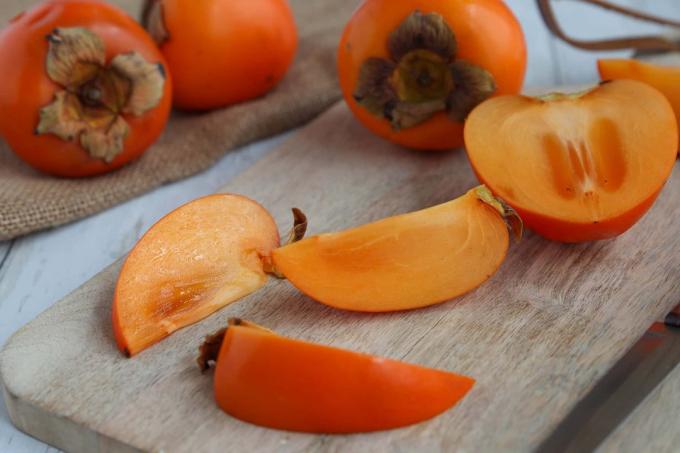
Even in our latitudes, persimmons have become an integral part of the menu. The exotic fruits are not only delicious, but also very healthy because of their high vitamin content. The article explains when the persimmon season begins.
To the point
- Persimmons originally come from Asia
- The main growing areas are now southern Europe, Brazil and Israel
- different seasons depending on the growing region
- Fruit provides a lot of energy thanks to its high glucose and vitamin A content
- ripe persimmons are soft and sensitive to pressure and have a sweet taste
Table of contents
- Growing areas
- Seasonal times
- Recognize ripe persimmons
- Grow your own persimmons
- frequently asked Questions
Growing areas
The heat-loving fruits, originally native to Asia, are now grown in many regions of the world.
The growing areas that also export persimmons to Germany are:
- Brazil
- Israel
- Southern Europe (especially Spain & Italy)

As a rule, the fruits are harvested locally unripe. This makes them easier to transport and allows them to mature along the way.
The ‘Sharon’ variety is grown in Israel. Your advantage: It has already been bred to the point where it... hardly any bitter tannins and contains no cores.
Seasonal times
The different cultivation areas for persimmons also have different harvest times per year. The seasons of the fruit vary greatly from growing region to growing region. However, this offers retailers the opportunity to offer the actual seasonal fruits to local consumers almost all year round:
- Brazil from March to July
- Europe from October to December
- Israel from November to February
As you can see from the season, there will hardly be any persimmons available in stores during the late summer months of August and September. If fruit is still available, it is usually a product that has been cooled for a longer period of time.
Recognize ripe persimmons
You can recognize a ripe persimmon by these characteristics:
- soft pulp
- Shell gives a little under pressure from outside
- no dark spots
- sweet taste

Only then is it suitable for consumption because the tannins it contains break down over the course of the ripening period. If you eat persimmons that are still unripe, you will get an unpleasant, stuffy and have a furry taste in the mouth.
With ripe persimmons, the peel can usually be eaten. However, since it has a very unique taste, the fruits are often peeled or spooned out. Important: If you want to eat the persimmon with the peel on, you should wash the fruit particularly well.
Grow your own persimmons
The fruits can also be grown in your own garden. However, the prerequisite for this is a mild climate, as is the case in many wine-growing regions. The persimmon trees also thrive quite well in these regions, but not so much in the harsher climate of the north. You should offer the following conditions to the frost-sensitive persimmon tree:
- warm location
- protected from cold easterly winds
- e.g. b. on south-facing house wall
- Courtyard ideal
- loamy, permeable soil
- Nutrient-rich, humus-rich substrate
- Fertilize with compost in spring
- water a lot in summer
The fruits in the local cultivated areas are usually ready for harvest in summer.
We recommend for your own cultivation the popular variety 'Sharon'.
frequently asked Questions
In many stores the fruits are only available from the beginning of October to the end of January. These are the persimmons that are grown in Europe and Israel. But you can increasingly find the tasty fruits at other times of the year. However, these are usually other types of persimmons that still contain seeds and tannin and come from more distant growing regions.
Persimmons that are available in local supermarkets outside of the European harvest season do not come from the region or at least from nearby growing areas. The fruits often travel a long way to reach the fruit shelves in supermarkets. Therefore, it is always a question of climate protection whether it is worth buying persimmons all year round or not.
If you have purchased immature persimmons from the supermarket, you can store them in the refrigerator for several weeks. The still firm fruits can ripen well here and thus have a longer shelf life. If you want them to ripen faster, simply leave the fruits in a bowl at room temperature for a few days. If you store the persimmons there together with apples, the ripening process can be accelerated even further.
